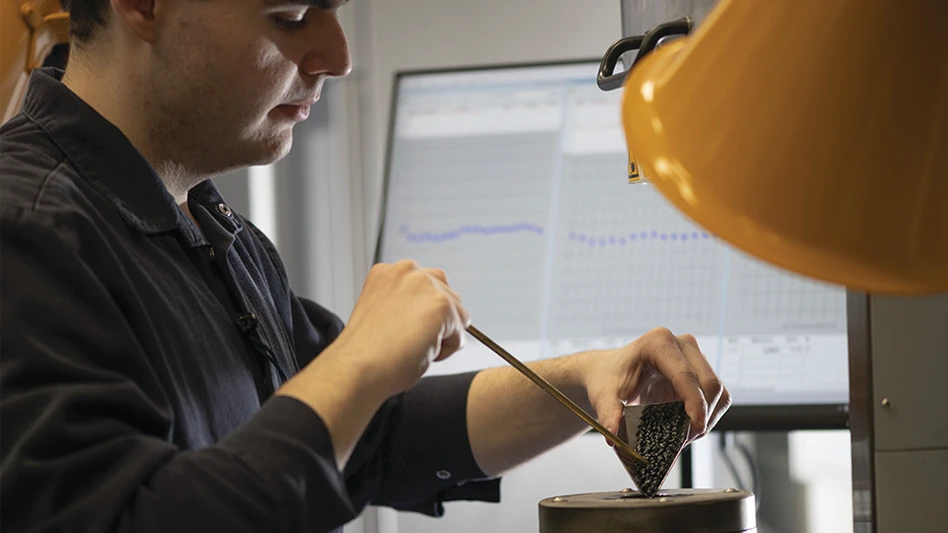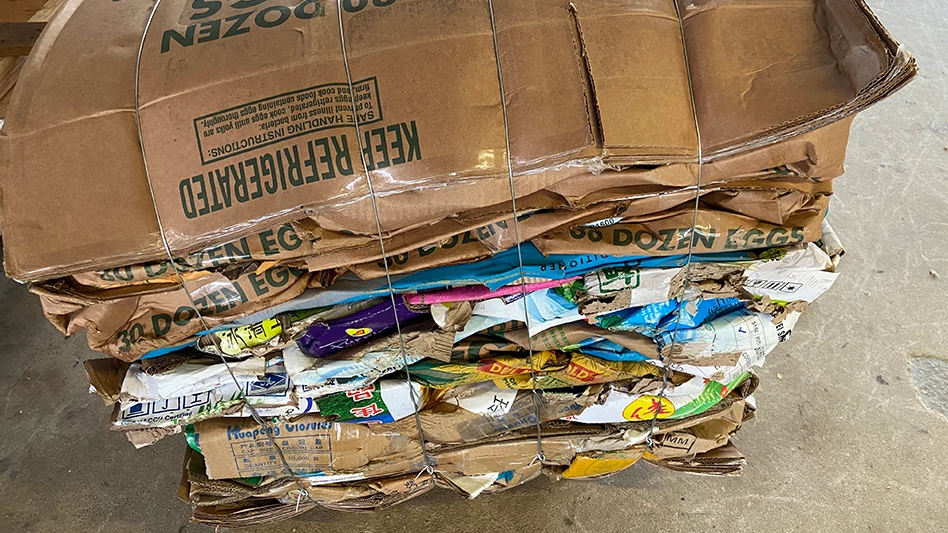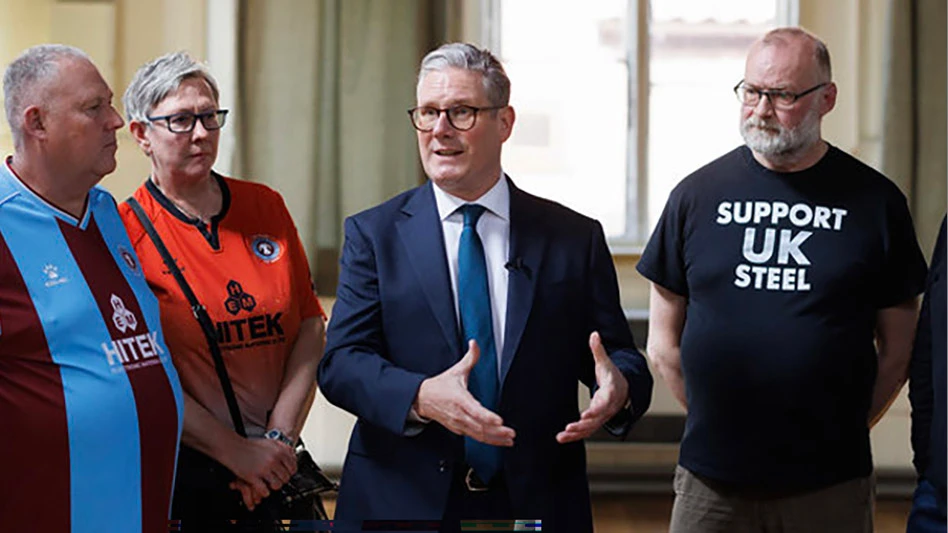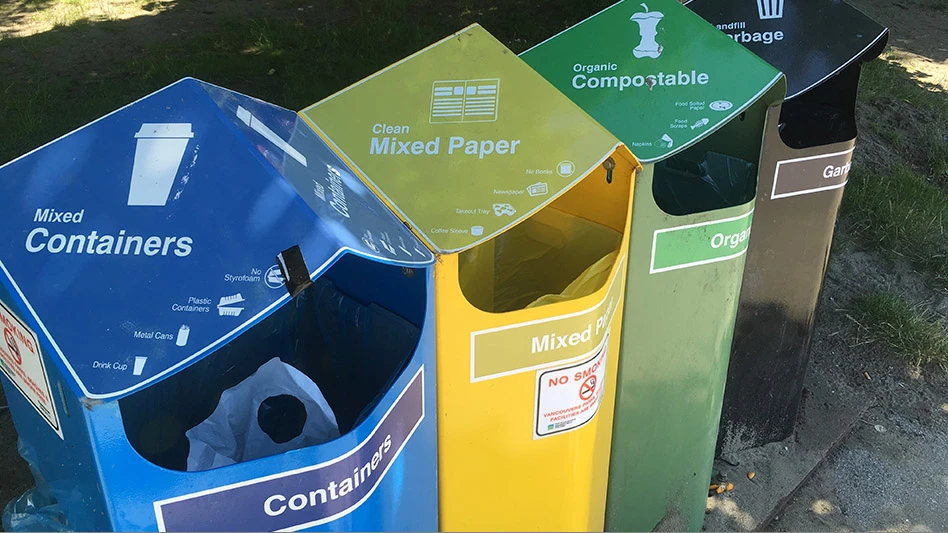 Operation Green Fence is an initiative of the Chinese central government that requires environmental officials and customs inspectors to be more exacting with inspections of container loads of mixed materials, including recycled plastics. With government backing, these officials were rejecting loads of recyclables they considered to be subpar. Bales of mixed plastics commonly had been shipped to China, though Operation Green Fence hampered this market in the last year and a half.
Operation Green Fence is an initiative of the Chinese central government that requires environmental officials and customs inspectors to be more exacting with inspections of container loads of mixed materials, including recycled plastics. With government backing, these officials were rejecting loads of recyclables they considered to be subpar. Bales of mixed plastics commonly had been shipped to China, though Operation Green Fence hampered this market in the last year and a half.
There is no question that, early on, Green Fence sent the market for mixed plastics reeling. The impact on the market for this material came as a surprise to some. However, there may be a rubber-band effect in that the market seems to have absorbed the initial impact and is now reverberating in new investments that have been made to process this material at home in the form of the growth of PRFs (plastics recovery facilities).
“All last year, we had 16 or 18 loads of mixed [plastics] stacked up here,” says Lee Cornell, director of mill supply for First Star Recycling, based in Omaha, Nebraska. Now, he says, “I can sell a lot more than I can get … huge amounts more.”
Part of that is because China’s policy has had two separate, and positive, impacts on the domestic market. For one, domestic buyers found themselves with less price and tonnage competition from overseas buyers. And, second, the suppliers became much more aware of the fact that buyers—domestic and overseas—want clean loads.
Others are seeing similar trends. “Since Green Fence was instituted, supply has gotten a little—just a little—looser for single-resin plastics,” says Patty Moore, principal at Moore Recycling Associates Inc., Sonoma, California. She studies the plastics recycling sector, including the role PRFs have in the processing chain.
Moore says nobody should have been surprised when, last year, China implemented Operation Green Fence. As long ago as 1996, the Chinese central government passed regulations that were updated in 2007 and 2009 leading to the 2013 action. In the meantime, the country trained more than 2,000 inspectors.
“The Chinese had been telling us for a couple of years that they were going to do this,” Moore says. “It has had a dramatic impact on nonbottle rigid plastics. It went from an easy market to a tougher one.”
Going forward, Moore says she expects that mixed plastics are not going to have much of a market in China. However, she says, the reverberations of Operation Green Fence could mean good things for the U.S. plastics market, both for reprocessors and for companies that manufacture recycling equipment.
Greg Janson, CEO of QRS Recycling, a regional PRF based in Louisville, Kentucky, says, “Green Fence has definitely hampered the flow [of recovered mixed plastics], but this is something that we committed to addressing before the Green Fence appeared.”
Janson says QRS provides the largest domestic market for Nos. 3 through 7 plastics. The company has a unique perspective on these plastics because it is not only a producer of but also a buyer and processor of this material stream.
“I think there are plenty of homes for No. 3 through No. 7 currently,” Janson says. “The combination of export to Asia, regional PRFs and refuse-derived fuel uses seem to be keeping things in balance. We have to compete for every pound we buy.”
QRS positions itself as a reliable, domestic solution for mixed bales of curbside generated containers, Nos. 1 through 7 plastic bottles and wash line residuals.
PRFs are taking in plastics that the MRFs (material recovery facilities) are not equipped to sort.
“We are seeing a number of new PRFs opening in the States. This had already happened in Canada,” Moore says.
The key for some of these facilities, she says, is “sorting for value.” Moore adds, “The value of a mixed plastic bale dropped dramatically after Green Fence.
However, she adds, “The price of a segregated bale barely moved. There are markets.”
For example, while the price of mixed rigid plastic bales fell from $140 per ton in January 2013 to just $20 per ton in May of that year. That same rigid plastic material segregated by type slipped only a little bit from $293 to $271 per ton.
“But,” Moore warns, “it has to be segregated either at the source, a MRF or PRF.”
Clean is cool
In the last year and a half since Operation Green Fence was enacted, Moore says, “Markets actually have opened up a bit, and prices are more realistic today.”
Markets are wide open to recyclers who deliver a good, clean product, sources say.
“People who don’t have a problem delivering clean material don’t have a problem with Green Fence and their markets,” says Arthur Boone, owner of the Center for Recycling Research, Berkeley, California.
Boone, a consultant with 35 years in the business, says Operation Green Fence is aimed at two primary targets. First, it is a measure to encourage collection of materials in China. Second, it is to clean up the materials that come into China from foreign sources.
“There are plants that say, ‘If it looks like plastic, it is plastic,’ … even if it is a paint can half-full of paint,” he says. With PET (polyethylene terephthalate) selling for 28 to 30 cents per pound, there is plenty of incentive for less-than-honest operators to bulk up loads of plastics with foreign materials ranging from stones to outright trash.
Although there initially was shock at China’s Operation Green Fence, most observers agree the Chinese government officials were right to implement the policy and that honest recyclers with decent quality control have little to fear about imports being banned. Yet, concerns linger.
China’s Operation Green Fence could greatly impact the recycling industry in the United States and worldwide, says Valerie Androutsopolous, principal of Vangel Inc. Baltimore. Founded in 1988, the company provides a range of services from secure data destruction to paper and plastics recycling.
“Currently the initiative is putting a great pressure on prices as recyclers are not shipping to China for fear of rejections,” she says. “More material is available domestically, so the domestic mills can pay less,” Androutsopolous says.
Operation Green Fence has not affected Vangel, she continues, with the exception of a customer who was recycling compact discs through the company. “So far, I’ve been told China is not accepting them,” she says of the discs.
What China does not accept, however, may be saleable to other markets. The mixed-material market, for instance, is still alive in other Asian countries.

Market's future
Despite the existence of a foreign mixed-material market, the future appears to be in good segregation of materials before they go to market.
QRS has PRFs in Louisville and Atlanta serving the Midwest and Southeast regions and is close to opening one in Baltimore to serve the Mid-Atlantic/Northeast.
Janson says a recycler cannot reliably get materials into China these days. “I know that some are moving to Asia, but I believe those are going to other countries as opposed to China,” he says. For this reason, he does not try to sell into China.
“As Operation Green Fence is rolled out and rules and regulations begin to change, it is clear that the amount of materials we export will be reduced,” Androutsopolous says. However, as single-stream recycling is becoming more widely adopted, we are producing even more contaminated materials. If China and other importers are operating at higher standards, where will all of the new contaminated materials go?
“Cleaner recyclables will help beef up our export business,” he adds.
Vangel is fortunate in that much of its plastics stream comes from office parks where No. 1 and No. 2 plastics are the norm. The company does see the odd coffee can or No. 6 drink cups, however.
“Domestic processors have learned to process No. 3 through No. 7 material. There are growing numbers of people who are handling it. I’m looking for all the No. 3 through No. 7 I can get my hands on,” says Cornell.
“But,” he warns, “it has to be clean—without metals, plastic bags or tuna sandwiches. The occasional No. 1 or No. 2 is fine, but it has to be clean.”
That is because most PRFs want clean stuff, just as the Chinese do. The majority of interest in Nos. 3 through 7 is for polypropylene (PP) along with some interest in LDPE (low-density polyethylene). Most buyers are looking for 50 percent or better yield on PP.
Moore says four things are needed for the system to work: identifiable raw materials, the technology to convert those materials, the ability to turn them into profitable products and investment money to allow recyclers to construct PRFs and similar plants.
A MRF usually will have a five-year contract for supply and focuses on moving material out as quickly and cheaply as it can. The typical PRF, however, buys in the spot market and has a difficult time showing a banker a guaranteed flow of material to put through that expensive equipment.
“I encourage communities and MRFs to commit at least a certain percentage of their material (to a PRF) on a contract basis,” Moore says. “Or, we need to develop some alternative funding mechanism like loan guarantees for PRFs.”
Take down that fence?
If China maintains its stance, the cost of exporting plastics and other materials could inch its way upward. Or, in the face of falling demand for a product that is seen as less than desirable, prices could fall as Chinese consumption falls. Either of these possible outcomes is based on the probability of China staying the course with its Green Fence policy. Because China’s appetite for scrap as a raw material is voracious, the Chinese manufacturers may put pressure on the government to relax the policy.
“When material is properly segregated by resin, it stays in the domestic market,” Moore says. “When it is segregated, we have domestic buyers for almost all of the components.”
PP appears to be the best seller among Nos. 3 through 7, with markets for most of the clean PP bales that are produced.
Some domestic areas are stronger than others. The Carolinas and Georgia, for example, have strong markets for PE (polyethylene) and PP.
QRS is always buying Nos. 3 through 7, Janson says, adding, “The Baltimore PRF will be quite large, so the demand is strong.”
Janson says he sees two distinct paths for Nos. 3 through 7 plastics. One is to use them for their Btu (British thermal units) value as a fuel source or for plastics-to-oil systems. The other path: mining their resource value.
“QRS has experimented with both, and we have chosen to mine the stream,” he continues.
“I personally hope China does not change its policy,” Androutsopolous says. “Why should we be shipping another country something they can’t use? Why are we shipping them garbage (as opposed to recyclables)? I think if it helps to clean up the commodity, everyone is better off all around.”
Androutsopolous says she is not overly concerned because Vangel’s line is hand-picked and produces a good level of quality. That, she says, is one of the benefits of being too small to be able to afford automatic sorting equipment.
“For the Chinese, the quality control issue is real. I don’t criticize the Chinese for this initiative,” Boone says, noting that Chinese companies need to get their money’s worth.
Currently, the possible profitability of PRFs is all the buzz within the industry.
Questions remain, however. “When does it make sense for a MRF to make an additional investment in sorting equipment, for example, another optical [scanner] to sort PP No. 5 versus having enough value left in the Nos. 3 through 7 stream to make it an attractive stream to sell?” Janson asks.
“We have found that a PRF can pull material from an approximate 400-to-600-mile radius,” Janson says. “We have also found that it takes that much range to effectively supply the investment.
“Before local MRFs invest more capital in sorting technology, they really need to consider running at optimal levels and then having a residual container stream that can be sold to a consistent and reliable domestic processor like QRS,” Jansen adds.
There is the chance that the Chinese, still craving recyclables but steadfast in their requirement for clean goods, will establish operations in the U.S. Or, they could partner with an American firm that is willing to produce cleaner recyclables.
Either outcome would be positive for manufacturers of sorting and baling equipment. It would be good for the environment. It would be good for the broader plastics recycling industry.
In short, Green Fence promises to give domestic recyclers the green light for plastics profits.
The author is a contributing editor to Recycling Today based in the Cleveland area. He can be contacted at curt@curtharler.com.

Explore the July 2014 Issue
Check out more from this issue and find your next story to read.
Latest from Recycling Today
- Commentary: How EPR is transforming the packaging industry
- Acerinox names new North American Stainless CEO
- Greenwave closes 2024 books with red ink
- Steel Dynamics nets $217M on record shipments
- Massive Chinese steelmaking rebound recorded in March
- LME looks into sustainable metal pricing
- OnePlanet Solar Recycling closes $7M seed financing round
- AMCS launches AMCS Platform Spring 2025 update





